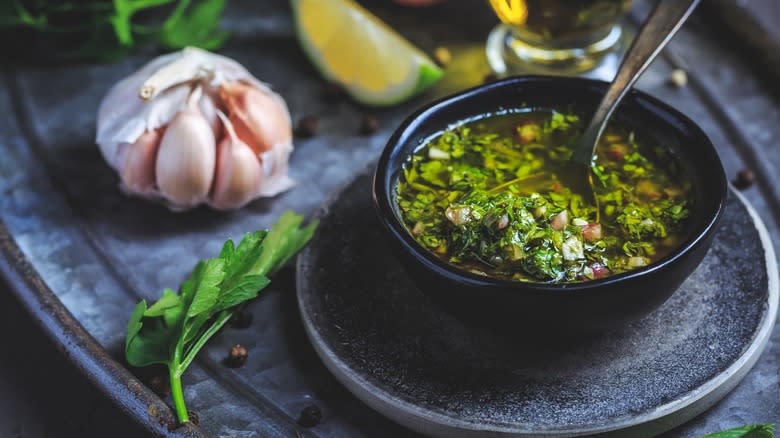What Is Persillade Sauce And What Does It Taste Like?

Many common sauces have French origins. But while you may be familiar with mayonnaise, béchamel, vinaigrette, and hollandaise, another French staple, persillade, remains relatively unknown, despite its immense potential to enhance dishes. Its name comes from a combination of two French words, "persil," which means parsley, and "ail" the word for garlic. As you might assume based on its name, parsley and garlic make up the main ingredients of a persillade. To bring these ingredients together into a sauce, the parsley and garlic are finely minced and then combined with oil and either lemon juice or vinegar. Sometimes, green onions are added along with capers and anchovies.
Though simple, persillade is a versatile sauce and is typically served as the finishing touch to a variety of dishes. You may have had it on escargot or oysters, but it also complements vegetables like potatoes and zucchini. At the same time, it's just as compelling in sandwiches or paired with different meats, such as juicy roast beef tenderloin.
Read more: French Cooking Tricks You Need In Your Life
What Persillade Sauce Tastes Like

Persillade sauce is traditionally made with fresh rather than dried parsley, so naturally it has a bright, herbaceous flavor. Persillade sauce also calls for raw garlic rather than roasted garlic or garlic powder, making the flavor more pungent. On top of this, persillade sauce has a tangy, acidic quality due to the vinegar or lemon juice, meaning it can balance out any richness or fattiness of the dishes it's added to. If you include anchovies and capers in your persillade, it'll also have briny, salty notes.
To maximize the flavor of your persillade, it's actually best not to serve it directly after making it. and instead let the ingredients marinate awhile so the flavors can develop further. Aim for around 30 minutes if you want your persillade to maintain its vibrant shade of green, because the longer you let it sit, the more the parsley will lose its color. Either way, it'll still last for as long as a week with refrigeration.
Persillade Sauce Vs Chimichurri

In terms of appearance, persillade sauce looks nearly identical to chimichurri, but there are more differences than just their originating cuisines. Though there is a good amount of overlap in the ingredients, chimichurri contains a blend of herbs rather than just parsley. Typically, it also includes cilantro and oregano, and you can even add kale. Instead of the green onion used in persillade sauce, chimichurri uses red onion, and because of the addition of red pepper flakes, chimichurri also packs a bit of heat. Persillade sauce on the other hand is not spicy.
Both persillade sauce and chimichurri contain oil and vinegar, but the different ratios result in a different consistency. In chimichurri, oil and vinegar is more of a main ingredient rather than a way to bring the parsley and garlic together. With less oil and vinegar, persillade isn't as saucy whereas chimichurri is runny enough to be drizzled onto food. Both are tasty options, but if you want a sauce where the garlic and parsley is especially prominent, you may want to opt for persillade over chimichurri.
Read the original article on Daily Meal.
